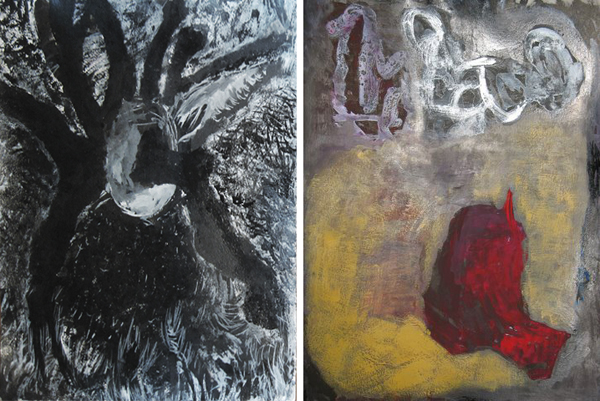
David Smith. Untitled, 1959. Black egg ink on paper. The Phillips Collection, gift of Linda Lichtenberg Kaplan, 2004. © Estate of David Smith/Licensed by VAGA, New York, NY
David Smith often used his drawings, paintings, and photography as a counterpoint to the relatively slow, laborious process of making welded sculpture. After a full day of sculpting at his studio near Lake George, New York, he would relax by taking a shower and spend the evening drawing; in the 1950s, he was making between 300 and 400 drawings a year. In an article in Arts Magazine in 1960, Smith wrote about the joy of making a drawing each day. He made the following annotations on a photograph of his living room floor filled with ink drawings: “Sometimes I draw for days I like it and it’s a balance with the labor of sculpture…to average a drawing for every day I live some form of identity.”
Intrigued by reading that David Smith had invented his own medium by adding an egg yolk to ink, I decided to try it myself. I put an egg yolk in a plastic container and mixed it with black Chinese ink. When I dipped a brush into the mixture, it was thick and creamy. The oil in the egg yolk added a surprising amount of density to the ink and a slight gloss. I experimented with five drawings on watercolor paper, adding white gouache on top of the black ink in a few of the pieces.

Two works by Librarian Karen Schneider using egg yolk mixed with Chinese ink, with other media, on watercolor paper.
The egg ink had a sensuous quality and flowed easily from the brush onto textured watercolor paper. To use it as David Smith did in his large, calligraphic drawings required decisiveness and a bold physicality. I came away from the experiment with a new appreciation of what it took to create Smith’s powerful drawings, informed by daily practice that led to a seemingly effortless fluidity of expression.
Karen Schneider, Librarian

Great article.
I visited the Phillips some months ago, and I saw this piece (which I like very much). I was intrigued by the medium notation, “black egg ink.”
Later, I did a search on the Internet, and I found a black ink recipe that used egg yolk. This was devised by Anne Marie Helmenstine, and the source website is noted below.
Lamp black is, of course, a dry pigment.
I haven’t tried making it myself, but you all can have a go at it!
By the way, can you send me the volume/issue number/date of the specific issue of “Arts Magazine” you reference? I wouldn’t mind reading the article myself.
Cheers, Roy
Black Ink Recipe
Ingredients
1/2 teaspoon lamp black
1 egg yolk
1 teaspoon gum arabic
1/2 cup honey
Directions
1. Mix together the egg yolk, gum arabic, and honey.
2. Stir in the lamp black. This will produce a thick paste which can be stored in a sealed container.
3. To use the ink, mix this paste with a small amount of water to achieve the desired consistency.
Anne Marie Helmenstine, PhD
Source: http://chemistry.about.com/od/inksandinkchemistry/a/black-ink-recipe.htm
Thanks for the new recipe, Roy! The issue referenced in the post is the February 1960 issue of Arts. It is actually displayed in the exhibition in a case, two copies to show the cover, where Smith was featured, as well as pages from the article that include Smith’s annotated photographs, providing insight into his process. I’ve included a photo of the case below.
i have a question why egg yolk is used in making an ink? what is the purpose of egg yolk?
i ask this because i’m doing my science investigatory project, and my product is ink. i would like to know why egg yolk used?
Hello Mr. Castillo,
I believe the egg was added to make a thicker, more viscous mixture that has a bit of gloss.
Thanks for your question,
Karen Schneider
I’ve been trying to do an art project using the recipe listed above by Roy, but I’m not having much luck with it. Any chance any one has advice?
Pingback: The Results of our Experiment « The Experiment Station